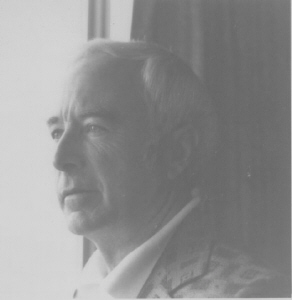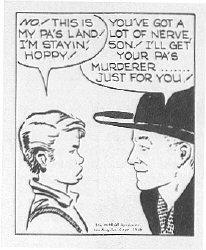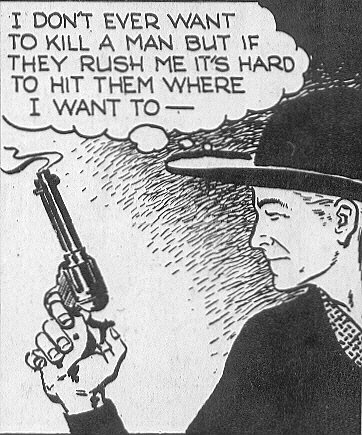|
AN INTERVIEW
WITH
DAN SPIEGLE
. |
 |
CONDUCTED
BY DAN GHENO
Originally
appearing in Graphic Story
World, 1972, Richard Kyle (Editor) |
|
Dan Spiegle,
Circa mid 70's
|
|
__________________________________ |
|
"I was born in Cosmopolis,
Washington in 1920. Then I moved over to Honolulu. When the stock market crash
came, I left its warm climate for Northern California, where I went through my
standard school years - and got the itch for drawing as a living...
________________________________________
|
Q: You've been one of the leading artists in comics for
more than twenty years---how did it all begin?
Dan Spiegle: In my last year at the
Chouinard Art Institute in Los Angeles---this was 1949---I realized that my GI Bill
was running out, and I thought it best if I looked for a job. A friend of mine
seeing my plight handed me a clipping from the classified ads of the newspaper:
Capitol Records needed an artist to draw a comic strip of theirs. At that time
I'd been working on a western comic strip and I thought that I'd pay a visit to
Capitol, show them my idea, and perhaps get the job.
Well, when I arrived they informed me that the comic strip
was
"Bozo the Clown," and of course I was let down because I
couldn't do that kind of strip. But when they saw my western strip, the man I
was talking to told me he was the brother-in-law of one of "Hopalong
Cassidy' s"---Bill Boyd' s--- managers, and that they were looking for an artist to
draw the famous cowboy in syndicated strip form. He told me to walk a couple of
blocks down the street to where "Hoppy's" main office was and see
if I could get the job.
"Hopalong
Cassidy' s"---Bill Boyd' s--- managers, and that they were looking for an artist to
draw the famous cowboy in syndicated strip form. He told me to walk a couple of
blocks down the street to where "Hoppy's" main office was and see
if I could get the job.
As the old saying goes, when you're lucky, you're lucky,
because I was very fortunate to find Bill Boyd in an agreeable mood. He liked
the way I drew horses and commented that it wouldn't matter how I drew him---I'd
learn how through practice----as he considered horses the most important in a Western
strip. He had another artist who could draw good horses in consideration and
told me he'd contact me if I got the job. Sure enough, a week later I got the
job.
Q: Were you always interested in comics? Some artists start
out planning to be illustrators, or to go into advertising...
Dan Spiegle: I've always liked to draw. From the time I
could hold a pencil, I'd scribble away. I used to go down to the dime store and
buy these little five cent tablets and draw on them, creating a continued story
throughout the tablets. It
was just a natural thing for me to do, to tell a story.
Q: Were you influenced by the comic strips appearing at
that time?
Dan Spieg1e: I don't really think I even looked at the comic
pages when I was young.
The first comic strip to really make an impression on me
was Alex Raymond's "Flash Gordon." Then there were "Tim
Tyler" and "Terry and the Pirates" while Caniff was still doing
it. I would say that Raymond influenced me the most and gave me the drive to
become a comic artist.
While I was in my second year in high school, I drew up a
comic strip,  colored it, and sent it to King Features -whom I'd always wanted to
work for. They sent it back and advised me that the next strip I sent in should
not be in color because the colors would print black. I thought it was very nice
of them to point out this fact that I was unaware of.
colored it, and sent it to King Features -whom I'd always wanted to
work for. They sent it back and advised me that the next strip I sent in should
not be in color because the colors would print black. I thought it was very nice
of them to point out this fact that I was unaware of.
After my school years, along came World War II, and I found
myself in the Navy. There, I did things for the base newspaper and insignias for
planes. Upon release from the service in `46 I took advantage of the GI Bill and
entered into Chouinard the same year.
I'd checked out many colleges, but found that none of them
were to my liking---you had to take too many minor courses on top of the ones you
really wanted to enroll in. I'd say this is true today, also. If you want to do
anything and do it well, you must put your whole back into it, and you can't be
bothered by what you could care less about---- like in my own practicing years, I
drew six hours a day, and I enjoyed
it. I know many a friend who enrolled in a university and
finally got so upset by all the minor, useless courses they had to take that
they quit, coming over to Chouinard.
Q: What was it like doing a syndicated strip for the first
time?
Dan Spiegle: It was rather difficult at first adjusting to
the schedule for "Hoppy." It took me all seven days to do a week's
amount of strips----and they wanted them six weeks ahead for
the dailies, and eight to ten weeks for the Sundays. But later I settled down to
taking only about four days for the week's worth and it helped me get ahead.
The first story was written by Dan Grayson, one of Bill
Boyd's finance managers, and myself----but after awhile we realized we just
couldn't come up with anything interesting, so we hired a writer named Royal
King Cole.

Like all writers, he had a tendency to overwrite things. He
would always inject unneeded adjectives in the box captions and bog down dialog
with long wordage. He'd go on and on, stealing my thunder since everything was
already written out and I couldn't even begin to create as much impact as I
would want to with my drawings. A reader can get frustrated with so many
descriptions in words when he can see what's going on by glancing at the
drawings. The drawing should always come first and the words second. I'm lucky
now, since at Western I can clean-up the dialog balloon when it gets too
cluttered. I never really cared for the stories that Royal wrote, anyway. They
just weren't interesting.

I used an awful lot of Craftint in my "Hoppy"
dailies---in fact, for a while, too much. I sort of got carried away, and seeing
how good it looked on the drawing board full scale, I was very proud. Things
look different when they're reproduced half-size, of course, and I was shocked
when I saw the mess I'd made. It's very hard to experiment as I did with Craftint, for you must wait a whole six weeks to see whether you accomplished what
you've set out for.
Q: Your characters are always pleasant looking...
Dan Spiegle: I always tried to make
Hoppy with a pleasant
face. I gave all his sidekicks a happy face because I don't like this
grim-faced, constantly-frowning approach most artists have. I see no reason for
it. I like to have a little humor in my characters, as much
as possible---but of  course if it's necessary to the storyline I will make the
character solemn appearing.
course if it's necessary to the storyline I will make the
character solemn appearing.
And then, too, Bill Boyd was always a very kind and
concerned man. Even at the peak of his great popularity he was never too busy to
give me the time of day. Often he would hold my oldest son on his knee. This
congeniality and love of children always showed through in his personal
appearances.
Q: Did any readers of "Hoppy" ever dislike or
disapprove of something you did in the strip?
Dan Spiegle: There was this one particular
character----I
spent a lot of time creating him, and I thought he was pretty good myself. He
was a Mexican and played the heavy. But I received a great many letters from
enraged people who thought I was typecasting Mexicans. I'm sure if it had been
any other minority I
would still have received flak, but I really thought I had
a good character and it didn't seem to me that I was downgrading anyone. From
then on we made it a point in our strip never to mention any nationality and to
always make the villain as general-looking as possible.
Naturally, I never tried to convey any message or
philosophy or opinion of my own. "Hopalong" really didn't belong to
me. He was someone else's, and I couldn't go against the cast they set for him.
So there was no subtleness in the strip of any kind.
Q: When did King Features buy out "Hopalong
Cassidy" from the original syndicate---the Mirror Syndicate?
Dan Spiegle: In 1951. They bought us out, and then they
sent for me to come to New York to get acquainted and talk things over. It
was here that I joined the National Cartoonists Society and
got involved with the organization.
King decided to make "Hopalong" a promotional
strip which means that they would put something like two unknown strips with
"Hoppy," and sell them as a package. They'd say, if you want "Hopalong
Cassidy" you have to take the other ones, as well.
"Hoppy" was extremely popular for a while,
hitting a peak of 200 plus newspapers. Eventually, the Western trend wore out
and "Hoppy" began slipping until King decided to drop us. We---Cole and
myself----looked into other syndicates, trying to sell off "Hoppy." But they
would only accept us if we took a cut in pay--- so Royal and I jointly decided to
abandon the venture.
Click
Here to Continue Reading.....
PART TWO OF THE DAN SPIEGLE INTERVIEW

 "Hopalong
Cassidy' s"---Bill Boyd' s--- managers, and that they were looking for an artist to
draw the famous cowboy in syndicated strip form. He told me to walk a couple of
blocks down the street to where "Hoppy's" main office was and see
if I could get the job.
"Hopalong
Cassidy' s"---Bill Boyd' s--- managers, and that they were looking for an artist to
draw the famous cowboy in syndicated strip form. He told me to walk a couple of
blocks down the street to where "Hoppy's" main office was and see
if I could get the job.
 colored it, and sent it to King Features -whom I'd always wanted to
work for. They sent it back and advised me that the next strip I sent in should
not be in color because the colors would print black. I thought it was very nice
of them to point out this fact that I was unaware of.
colored it, and sent it to King Features -whom I'd always wanted to
work for. They sent it back and advised me that the next strip I sent in should
not be in color because the colors would print black. I thought it was very nice
of them to point out this fact that I was unaware of.

 course if it's necessary to the storyline I will make the
character solemn appearing.
course if it's necessary to the storyline I will make the
character solemn appearing.